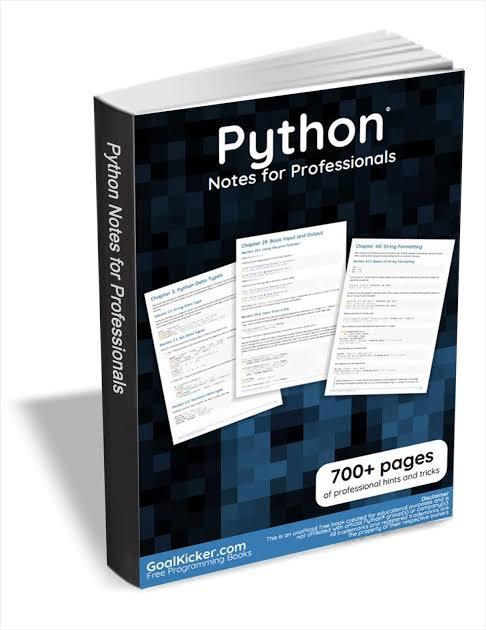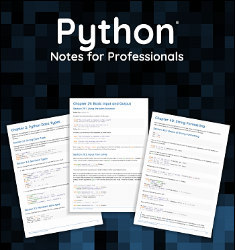Don't wanna be here? Send us removal request.
Text


Python Hints and Tips for Professionals
Author: Peter Ranieri
Download Now
Python features a dynamic type system and automatic memory management. It supports multiple programming paradigms, including object-oriented, imperative, functional and procedural, and has a large and comprehensive standard library.
Python interpreters are available for many operating systems. CPython, the reference implementation of Python, is open source software and has a community-based development model, as do nearly all of Python's other implementations. Python and CPython are managed by the non-profit Python Software Foundation.
Python is a multi-paradigm programming language. Object-oriented programming and structured programming are fully supported, and many of its features support functional programming and aspect-oriented programming (including by metaprogramming and metaobjects (magic methods)). Many other paradigms are supported via extensions, including design by contract and logic programming.
Python uses dynamic typing, and a combination of reference counting and a cycle-detecting garbage collector for memory management. It also features dynamic name resolution (late binding), which binds method and variable names during program execution.
Python's design offers some support for functional programming in the Lisp tradition. It has filter(), map(), and reduce() functions; list comprehensions, dictionaries, and sets; and generator expressions. The standard library has two modules (itertools and functools) that implement functional tools borrowed from Haskell and Standard ML.
The language's core philosophy is summarized in the document The Zen of Python (PEP 20), which includes aphorisms such as:
Beautiful is better than ugly
Explicit is better than implicit
Simple is better than complex
Complex is better than complicated
Readability counts
Rather than having all of its functionality built into its core, Python was designed to be highly extensible. This compact modularity has made it particularly popular as a means of adding programmable interfaces to existing applications. Van Rossum's vision of a small core language with a large standard library and easily extensible interpreter stemmed from his frustrations with ABC, which espoused the opposite approach.
While offering choice in coding methodology, the Python philosophy rejects exuberant syntax (such as that of Perl) in favor of a simpler, less-cluttered grammar. As Alex Martelli put it: "To describe something as 'clever' is not considered a compliment in the Python culture." Python's philosophy rejects the Perl "there is more than one way to do it" approach to language design in favor of "there should be one—and preferably only one—obvious way to do it".
Python's developers strive to avoid premature optimization, and reject patches to non-critical parts of the CPython reference implementation that would offer marginal increases in speed at the cost of clarity. When speed is important, a Python programmer can move time-critical functions to extension modules written in languages such as C, or use PyPy, a just-in-time compiler. Cython is also available, which translates a Python script into C and makes direct C-level API calls into the Python interpreter.
Read more
An important goal of Python's developers is keeping it fun to use. This is reflected in the language's name — a tribute to the British comedy group Monty Python — and in occasionally playful approaches to tutorials and reference materials, such as examples that refer to spam and eggs (from a famous Monty Python sketch) instead of the standard foo and bar.
A common neologism in the Python community is pythonic, which can have a wide range of meanings related to program style. To say that code is pythonic is to say that it uses Python idioms well, that it is natural or shows fluency in the language, that it conforms with Python's minimalist philosophy and emphasis on readability. In contrast, code that is difficult to understand or reads like a rough transcription from another programming language is called unpythonic.
Read more
0 notes
Text

CSS Notes Professionals E-book
Download
Subjects covered include:
Getting started with CSS
Structure and Formatting of a CSS Rule
Comments
Selectors
Backgrounds
Centering
The Box Model
Margins
Padding
Border
Outlines
Overflow
Media Queries
Floats
Typography
Flexible Box Layout (Flexbox)
Cascading and Specificity
Colors
Opacity
Length Units
Pseudo-Elements
Positioning
Layout Control
Grid
Tables
Transitions
Animations
2D Transforms
3D Transforms
Filter Property
Cursor Styling
box-shadow
Shapes for Floats
List Styles
Counters
Functions
Custom Properties (Variables)
Single Element Shapes
Columns
Multiple columns
Inline-Block Layout
Inheritance
CSS Image Sprites
Clipping and Masking
Fragmentation
CSS Object Model (CSSOM)
Feature Queries
Stacking Context
Block Formatting Contexts
Vertical Centering
Object Fit and Placement
CSS design patterns
Browser Support & Prefixes
Normalizing Browser Styles
Internet Explorer Hacks
Performance
Cascading Style Sheets (CSS) is a style sheet language used for describing the presentation of a document written in a markup language like HTML. CSS is a cornerstone technology of the World Wide Web, alongside HTML and JavaScript.
CSS is designed to enable the separation of presentation and content, including layout, colors, and fonts. This separation can improve content accessibility, provide more flexibility and control in the specification of presentation characteristics, enable multiple web pages to share formatting by specifying the relevant CSS in a separate .css file, and reduce complexity and repetition in the structural content.
Separation of formatting and content also makes it feasible to present the same markup page in different styles for different rendering methods, such as on-screen, in print, by voice (via speech-based browser or screen reader), and on Braille-based tactile devices. CSS also has rules for alternate formatting if the content is accessed on a mobile device.
The name cascading comes from the specified priority scheme to determine which style rule applies if more than one rule matches a particular element. This cascading priority scheme is predictable.
The CSS specifications are maintained by the World Wide Web Consortium (W3C). Internet media type (MIME type) text/css is registered for use with CSS by RFC 2318 (March 1998). The W3C operates a free CSS validation service for CSS documents.
In addition to HTML, other markup languages support the use of CSS including XHTML, plain XML, SVG, and XUL.
CSS has a simple syntax and uses a number of English keywords to specify the names of various style properties.
A style sheet consists of a list of rules. Each rule or rule-set consists of one or more selectors, and a declaration block.
Read more
0 notes
Text
NASA’s New Hubble E-Book Takes Readers on a Journey to Curious Worlds Download Now E-Book
For thousands of years, people believed Earth was fixed at the center of the universe and that every other celestial object revolved around our planet. But over time, it became clear that Earth did not occupy such a special position. People began to see that perhaps Earth was not as unique as they thought. Some even wondered if there might be planets circling other stars.
Weird Worlds and Other Earths
To date, astronomers have found more than 5,000 exoplanets. While astronomers initially expected to find systems similar to ours, most of the first exoplanets they discovered were wild and exotic compared to our solar system. Hubble’s exoplanet studies continue to help broaden our view of planetary systems by revealing even more oddballs, often by investigating the chemistry of their atmospheres via spectroscopy – the study of the information coded in light.
Hubble’s spectroscopic observations have unveiled withering worlds that dwindle as they lose their atmospheres to space, and planets in bizarre orbits. But the observatory has also revealed worlds that are more similar to our own. Hubble has studied exoplanets’ atmospheres and found several that contain water vapor – an essential ingredient for life as we know it. Some of these worlds even orbit within their star’s habitable zone, which is the range of orbital distances where temperatures are mild enough that liquid water could pool on planetary surfaces. “Hubble has provided us with a wealth of information on the variety that exists among exoplanets, probing the composition of their atmospheres and discovering exotic weather seen nowhere on Earth or even elsewhere in our solar system,” said Ken Carpenter, Hubble’s operations project scientist based at NASA Goddard Space Flight Center. “It has also carried out an extremely critical exploration of relationship between these exoplanets and their host stars and how it drives conditions on the planetary surfaces that influence their habitability. Hubble has shown us that even stars unlike our Sun may harbor habitable worlds and thus broadened our search for life elsewhere in the galaxy.”
Read details

1 note
·
View note